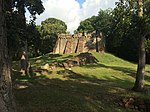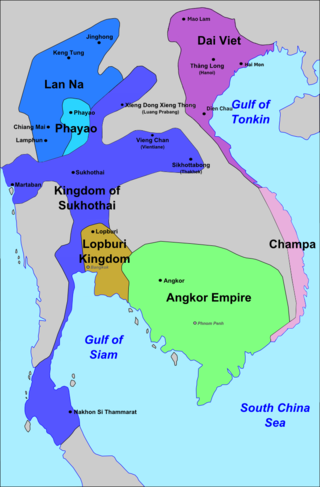
The Sukhothai Kingdom or the Northern Cities was a post-classical Siamese kingdom (mandala) in Mainland Southeast Asia surrounding the ancient capital city of Sukhothai in present-day north-central Thailand. The kingdom was founded by Si Inthrathit in 1238 and existed as an independent polity until 1438, when it fell under the influence of the neighboring Ayutthaya after the death of Borommapan.
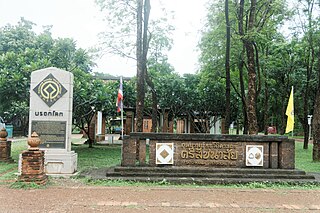
In Thailand, historical parks are protected areas managed by the Fine Arts Department for their historical value, usually covering an extensive group of archaeological sites in an area, which are themselves legally protected as ancient monuments.

Ayutthaya Historical Park covers the ruins of the old city of Ayutthaya, Phra Nakhon Si Ayutthaya Province, Thailand. The city of Ayutthaya was founded by King Ramathibodi I in 1351,[a] though it is likely to be significantly older, based on evidence showing that the area was already populated during the Mon Dvaravati period. Sources further mention that around 850 AD, the Khmers occupied the area and established a stronghold there, naming it Ayodhya, after one of the holiest Hindu cities in India of the same name. The early history of Ayutthaya is connected to this Khmer settlement. Additionally, Prince Damrong has also attested to the existence of a city named Ayodhya, founded by the Khmers ruling from Lopburi at the point where the three rivers meet. An excavation map shows traces of an ancient baray close to the southwestern tip of Wat Yai Chai Mongkhon, which could have been built on a former important Khmer temple complex.

Dvaravati was an ancient Mon political principality from the 6th century to the 11th century, located in the region now known as central Thailand, and was speculated to be a succeeding state of Lang-chia or Lang-ya-hsiu (หลังยะสิ่ว). It was described by Chinese pilgrims in the middle of the 7th century as a Buddhist kingdom named To-lo-po-ti situated to the west of Isanapura (Cambodia), to the east of Sri Ksetra (Burma), and adjoined Pan Pan in the South. Its northern border met Chia-lo-she-fo, which was speculated to be either Kalasapura, situated along the coast of the Bay of Bengal somewhere between Tavoy and Rangoon, or Canasapura in modern northeast Thailand. Dvaravati sent the first embassy to the Chinese court in around 605–616.
The culture of Thailand is a unique blend of various influences that have evolved over time. Local customs, animist beliefs, Buddhist traditions, and regional ethnic and cultural practices have all played a role in shaping Thai culture. Thainess, which refers to the distinctive qualities that define the national identity of Thailand, is evident in the country's history, customs, and traditions. While Buddhism remains the dominant religion in Thailand with more than 40,000 temples, Islam, Christianity, and other faiths are also practiced.

Thai art refers to a diverse range of art forms created in Thailand from prehistoric times to the present day, including architecture, sculpture, painting, textiles, decorative arts, crafts, ceramics, and more. While Buddhism has played a significant role in Thai art, with many sculptures and paintings depicting Buddha images and religious themes, nature, including flora and fauna, as well as mythical creatures, has been a major inspiration for Thai art, with colorful motifs appearing in various types of art forms. In contemporary Thai art, traditional works remain significant and continue to influence artists' concepts.

The Thung Yai Naresuan Wildlife Sanctuary is a protected area in Thailand in the northern part of Kanchanaburi Province and the southern part of Tak Province. It was declared a wildlife sanctuary in 1972, and a World Heritage Site by UNESCO in 1991 together with the adjoining Huai Kha Khaeng Wildlife Sanctuary.
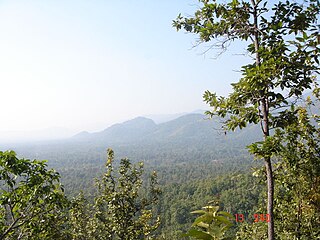
The Huai Kha Khaeng Wildlife Sanctuary is in Uthai Thani and Tak Provinces, Thailand. The park was established in 1974, and is part of the largest intact seasonal tropical forest complex in Mainland Southeast Asia. It, coupled with the Thungyai Naresuan Wildlife Sanctuary was declared a World Heritage Site by the United Nations in 1991. Together, the two sanctuaries occupy 622,200 hectares. As of 2014 it still contained viable populations of large mammals, including gibbons, bears, elephants and Indochinese tigers, although like all other sites in mainland Southeast Asia, some species have disappeared or have experienced severe declines.

Wat Phra That Phanom is a Buddhist temple in the That Phanom District in the south of Nakhon Phanom Province, all within the Isan region of Thailand near the Lao border. According to local legend, the temple contains in the pagoda the Phra Uranghathat (พระอุรังคธาตุ)/Phra Ura (พระอุระ)/Buddha's breast bones. As such, it is one of the most important structures for Theravada Buddhists and the most important Buddhist site in the province, with an annual week-long festival being held in the town of That Phanom to honour the temple. These festival attract thousands of people who make pilgrimages to the shrine. In Thai folk Buddhism, Wat Phra That Phanom is a popular pilgrimage destination for those born in the year of the Monkey.

The Si Satchanalai Historical Park is a historical park in Si Satchanalai district, Sukhothai Province, northern Thailand. The park covers the ruins of Si Satchanalai and Chaliang. Si Satchanalai, which literally means "City of good people", was founded in 1250 as the second center of the Sukhothai Kingdom and as a residence of the crown prince in the 13th and 14th centuries.

Kamphaeng Phet Historical Park is an archeological site in Kamphaeng Phet, Thailand. Along with Sukhothai Historical Park and Si Satchanalai historical park, it is a part of the UNESCO World Heritage Site Historic Town of Sukhothai and Associated Historic Towns. Major features in the Kamphaeng Phet Historical Park include archaeological remains of ancient sites such as Mueang Chakangrao to the east of the Ping River, Mueang Nakhon Chum to the west and Mueang Trai Trueng some 18 km from the town to the southwest. Chakangrao, the ancient Kamphaeng Phet town, had the same town planning concept as the old Sukhothai and Si Satchanalai, with separate zones for religious sites both within and outside of town limits. Structures are usually large and made of laterite. Religious sites on the west bank of the Ping River at Nakhon Chum are built of bricks and of smaller size.

The Lavo Kingdom was a political entity (mandala) on the left bank of the Chao Phraya River in the Upper Chao Phraya valley from the end of Dvaravati civilization, in the 7th century, until 1388. The original center of Lavo civilization was Lavo.
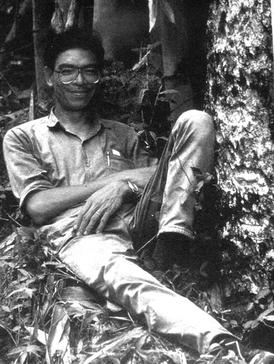
Seub Nakhasathien was a Thai conservationist, environmental activist, and scholar who is renowned for his effort to protect Cheow Lan Lake, Thungyai Naresuan Wildlife Sanctuary, and Huai Kha Khaeng Wildlife Sanctuary. Seub committed suicide to signify the importance of the environment and to preserve it. According to the Bangkok Post, "The death of Seub Nakhasathien, a forest conservator who committed suicide in 1990,...helped transform the status of Thungyai Naresuan and the adjacent Huay Kha Kaeng Western Forest Complex into a sacrosanct site and inspired many youth to become forest patrol staff."
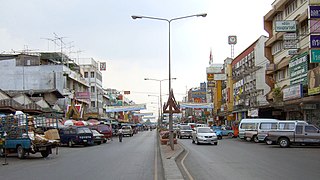
Phra Nakhon Si Ayutthaya, or locally and simply Ayutthaya is the capital of Phra Nakhon Si Ayutthaya province of Thailand. Ayutthaya was the capital of the Ayutthaya Kingdom. Located on an island at the confluence of the Chao Phraya and Pa Sak rivers, Ayutthaya is the birthplace of the founder of Bangkok, King Rama I. The ruins of the old city are preserved in the Ayutthaya Historical Park.

The Dawna Range, also known as Dawna Hills, is a mountain range in eastern Burma and northwestern Thailand. Its northern end is located in Kayah State where it meets the Daen Lao Range, a subrange of the Shan Hills. The range runs southwards along Kayin State as a natural border with Mon State in the west forming parallel ranges to the northern end of the Tenasserim Hills further south and southeast. The Dawna Range extends east of the Salween southwards from the Shan Hills for about 350 km, at the western limit of the Thai highlands. Its southern end reaches the Thai-Myanmar border in the Umphang area, entering Thailand west of Kamphaeng Phet. The Thungyai Naresuan Wildlife Sanctuary is in the Thai side of the range.

Wat Phra Mahathat Woramahawihan is the main Buddhist temple (wat) of Nakhon Si Thammarat Province in southern Thailand. The main stupa of the temple, Phra Borommathat Chedi, was built by King Sri Dhammasokaraja in the early-13th century CE to establish a symbol for the Theravada Buddhism sect in the province. The temple is believed to house a tooth of Gautama Buddha.

Thungyai–Huai Kha Khaeng Wildlife Sanctuaries is the inscribed name of a UNESCO World Heritage Site in Thailand covering the areas of two adjacent wildlife sanctuaries: Thung Yai Naresuan and Huai Kha Khaeng. They cover areas in Kanchanaburi, Tak and Uthai Thani provinces, and form a large part of Thailand's Western Forest Complex. The site was inscribed on the World Heritage list in 1991.

Si Thep Historical Park is an archaeological site in Thailand's Phetchabun province. It covers the ancient city of Si Thep, a site inhabited from around the third to fifth century CE until the thirteenth century, spanning cultural periods from late prehistory, through Dvaravati, to the golden age of the Khmer Empire. Si Thep was one of the largest known city-states that emerged around the plains of central Thailand in the first millennium, but became abandoned around the time the Thai-speaking cities of Sukhothai and later Ayutthaya emerged as new centres of power in the Chao Phraya River basin.














